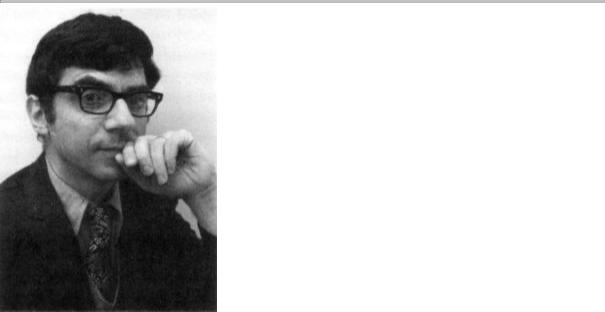
Erik_Kandel_-_V_poiskakh_pamyati_angl
.pdf
Finally I tried to simulate aversive classical conditioning. This form of classical conditioning teaches an animal to associate an unpleasant stimulus, such as an electric shock, with a stimulus that ordinarily elicits no response. The neutral stimulus must always precede the aversive stimulus and in this way will come to predict it. For example, Pavlov used a shock to a dog's paw as an aversive stimulus. The shock caused the animal to raise and withdraw its leg, a fear response. Pavlov found that after several trials in which he paired the shock with the ringing of a bell—first sounding the bell and then administering the shock—the dog would withdraw its leg whenever the bell sounded, even if no shock followed. Thus, aversive classical conditioning is an associative form of learned fear (figure 11-2).
Aversive classical conditioning resembles sensitization in that activity in one sensory pathway enhances activity in another, but it differs in two ways. First, in classical conditioning an association is formed between a pair of stimuli that occur in rapid sequence. Second, classical conditioning enhances an animal's defensive responses to the neutral stimulus only, not to environmental stimuli in general, as sensitization does.
Therefore, in my experiments on aversive classical conditioning in Aplysia, I repeatedly paired a weak stimulus to one neural pathway with a strong stimulus to another pathway. The weak stimulus came first and acted as a warning of the strong stimulus. The pairing of the two stimuli greatly enhanced the cell's response to the weak stimulus; moreover, that enhanced response was far greater than the cell's enhanced response to the weak stimulus in the sensitization experiments (figure 11-2). The added boost was critically dependent on the timing of the weak stimulus, which had unfailingly to precede and predict the strong stimulus.
These experiments confirmed what I had suspected—namely, that
a pattern of stimulation designed to mimic the patterns used to induce learning in behavioral studies can change the effectiveness of a neuron's communication with other nerve cells. The experiments clearly showed that synaptic strength is not fixed—it can be altered in different ways by different patterns of activity. Specifically, the neural analogs of sensitization and aversive classical conditioning strengthened a synaptic connection, whereas the analog of habituation weakened the connection.
Thus, Tauc and I had discovered two important principles. First, the strength of the synaptic communication between nerve cells can be changed for many minutes by applying different patterns of stimulation derived from specific training protocols for learned behavior in animals. Second, and even more remarkable, the same synapse can be strengthened or weakened by different patterns of stimulation. These findings encouraged Tauc and me to write in our paper in the Journal of Physiology:
The fact that the connections between nerve cells can be strengthened for over half-an-hour with an experimental protocol designed to simulate a behavioral conditioning paradigm also suggests that the concomitant changes in the synaptic strength may underlie certain simple forms of information storage in the intact animal.
What most impressed us was how readily the strength of synapses could be altered by different patterns of stimuli. This suggested that synaptic plasticity is built into the very nature of the chemical synapse, its molecular architecture. In the broadest terms it suggested that the flow of information in the various neural circuits of the brain could be modified by learning. We did not know whether synaptic plasticity was an element of actual learning in the intact, behaving animal, but our results suggested that the possibility was very much worth pursuing.
Aplysia was proving to be more than a wonderfully informative experimental system; it was an extremely enjoyable one to work with as well. What had started out as an infatuation based on the hope of finding a suitable animal was turning into a serious commitment. Moreover, because Aplysia's cells are large (cell R2, in particular, is
gigantic—1 millimeter in diameter and visible to the naked eye), the technical demands of the experiments were less severe than those on the hippocampus.

The experiments were also more leisurely. Because placing a tiny electrode into such a gigantic cell causes essentially no damage, one can effortlessly record from cell R2 for five to ten hours. I could go to lunch and come back to find the cell still in perfect health, waiting for me to pick up the experiment where I had left off. This compared very favorably to the many nights Alden and I had had to work to obtain an occasional recording of ten to thirty minutes from the pyramidal cells of the hippocampus. A typical experiment in Aplysia could be completed in six to eight hours: as a result, the experiments became great fun.
In this mood, after a season of working on Aplysia, I was reminded of a story Bernard Katz had told me about the great physiologist A. V Hill, his mentor at University College, London. On Hill's first visit to the United States, in 1924, shortly after having won the Nobel Prize at age thirty-six for his work on the mechanism of muscular contraction, he gave a talk on the subject at a scientific meeting. At the end of the talk, an elderly gentleman rose and asked him about the practical use of his research.
Hill pondered for a moment as to whether he should enumerate the many instances in which great benefits for mankind have arisen from experiments undertaken purely to satisfy intellectual curiosity. Rather than take this path, however, he simply turned to the man and said with a smile, "To tell the truth, sir, we don't do it because it's useful; we do it because it's amusing."
On a personal level, these studies were pivotal to my confidence as an independent scientist. When I first arrived and talked about learning and analogs of learning, the other postdoctoral fellows' eyes simply glazed over. In 1962, talking to most cellular neurobiologists about learning was a little bit like talking to the moon. By the time I left, however, the tenor of discussions in the laboratory had changed.
I also felt that I was developing a style of doing science. Even though I still felt myself inadequately trained in some areas, I proved to be quite bold in approaching scientific problems. I did experiments that I thought were interesting and important. Without quite know-
ing it, I had found my voice, much as a writer must feel after having written a number of satisfactory stories. With that finding came self-assurance, a sense that I could make a go of it in science. After my fellowship with Tauc, I never again had the fear that I would run out of ideas. I had many moments of disappointment, despondency, and exhaustion, but I always found that by reading the literature and showing up at my lab looking at the data as they emerged day by day and discussing them with my students and postdoctoral fellows, I would gain a notion of what to do next. We would then discuss these ideas over and over again. When I tackled the next problem, I would immerse myself in reading about it.
As I had done when selecting Aplysia to study, I learned to trust my instincts, to unconsciously follow my nose. Maturation as a scientist involves many components, but a key one for me was the development of taste, much as it is in the enjoyment of art, music, food, or wine. One needs to learn what problems are important. I sensed myself developing taste, distinguishing what was interesting from what was not—and among the things that were interesting, I also learned what was doable.
BEYOND THE PLEASURE OF THE SCIENCE, OUR FOURTEEN MONTHS'
stay in France was a transforming experience for Denise and me. Because we so enjoyed Paris and because Aplysia was so easy to work with, I did not work on weekends for the first time in years and was home for dinner every night at seven. We used our leisure time to see Paris and its environs. We began to visit art galleries and museums on a regular basis, and we purchased, after much financial agonizing, our first works of art. One was a wonderful self-portrait in oil by Claude Weisbusch, an Alsatian artist who had recently won an award as the young painter of the year and who used rapid, nervous strokes reminiscent of Kokoschka. We also bought a tender Mother and Child, an oil by Akira Tanaka. Our largest investment was a beautiful etching by Picasso of the artist and his models, number 82 of the Vollard Suite, published in 1934. In this marvelous etching, each of the four women is drawn

in a different style. Denise thought she could recognize three of these women as having been important to Picasso at dif-
ferent points in his early life: Olga Koklova, Sarah Murphy, and Marie-Thérèse Walter. We still greatly enjoy looking at these three beautiful works.
The French species of Aplysia that Ladislav Tauc worked with came from the Atlantic Ocean. The system for supplying the snails was not very reliable, so it was difficult to obtain them in Paris. We therefore spent close to the entire autumn of 1962 and 1963 in Arcachon, a beautiful little resort not far from Bordeaux. I conducted most of my experiments on Aplysia in Arcachon and then analyzed the data in Paris, where I also carried out some experiments on the land snail.
As if several months in Arcachon were not vacation enough, Tauc, the members of his laboratory, and all of France considered vacationing during the month of August sacred. We joined in that belief. We rented a house on the Mediterranean in the Italian town of Marina di Pietra Santa, about an hour and a half from Florence, and we visited the city three or four times a week. On other holidays, we would travel near and far. We went to Versailles, just outside of Paris, and to Cahors, in the south of France, to visit the convent where Denise was hidden during the war.
In Cahors, we spoke to a nun who remembered Denise and showed us pictures of her dormitory room, with ten cots arranged neatly on each side, and a photograph of Denise with the other girls in her class. The nun pointed out that one of the other girls was also Jewish but that neither Denise nor this girl knew of the other's identity. To protect them, none of the students was informed that there were Jews among them. Each of the Jewish girls was taken aside by the Mother Superior and shown a private escape route, a passage through a tunnel to be used if the Gestapo came searching for Jewish students.
About twenty miles from Cahors, in a very small village of two hundred inhabitants, we visited the baker Alfred Aymard and his wife, Louise, who had sheltered Denise's brother. That was certainly one of the most remarkable days in our year in France. Aymard, a Communist, took in Denise's brother not because he necessarily liked Jews, but because he hated the Nazis. Within a few months, he came to adore Jean-Claude and had a difficult time parting with him at the end of the war. The Bystryns sensed this difficulty and in the years
after the war spent part of each summer vacationing with Aymard and his wife.
When we arrived for our visit, Aymard insisted that we stay overnight. He had recently suffered a stroke, which slowed his speech and left him partially paralyzed on the left side, but he was nonetheless jovial and extremely generous. He cleared out his and his wife's bedroom and ran an electric extension cord into the bedroom so we could have better light. Despite my repeated insistence that he stay in their room, Aymard and his wife insisted that we, the guests, should have the best room while the two of them slept in the kitchen. During dinner, we tried to repay his kindness with one story after another about Jean-Claude, whom Aymard still missed seventeen years later.
In another trip Denise and I shall not readily forget, we stayed for the night in Carcassonne, a medieval walled city in the south of France. We arrived in the late evening and had a difficult time finding a room. Finally, we located one in a small hotel. The room, however, had only a single, rather large bed. We put Paul in the center, changed into our sleeping clothes, and climbed into bed on either side of him. Accustomed to sleeping alone, Paul instantly rebelled and started to scream in protest. We tried repeatedly to calm him down; when this failed, we climbed out of the bed and lay down on either side of it, surrendering it to him. Denise and I at first appreciated the quiet we had won by lying on the floor. But after ten minutes of discomfort, we realized that we could not easily fall asleep there. So we turned from being progressive parents to being disciplinarians. We

climbed back into bed and resolutely refused to leave. Within minutes, all was calm and the three of us slept through the night.
Living in France also enabled me to see my brother on a regular basis. When we had arrived in New York from Vienna in 1939, Lewis was fourteen and had been an academic star throughout his school years. Despite his academic ambitions, he sensed that his major efforts should be to help support our family, since my father's income was small and the Depression had not yet ended. So rather than enrolling in an academic curriculum, he went to the New York High School for Specialty Trades and learned to be a printer, a trade he enjoyed because he liked books so much. Through high school and his first
two years at Brooklyn College, Lewis worked part-time for a printer; this gave him some money for our family plus a bit extra to feed his addiction to Wagnerian opera, a habit he satisfied by purchasing standing-room tickets. When he was nineteen, he was drafted into the U.S. Army and sent to Europe, where he fought and was wounded by shrapnel in the Battle of the Bulge, Germany's last-ditch effort to keep the advancing American army at bay.
Upon receiving an honorable discharge, Lewis joined the army reserve and rose to the rank of lieutenant. All service personnel were eligible for the G.I. Bill, which enabled them to go to the college of their choice tuition free. Lewis went back to Brooklyn College and continued to study engineering and German literature. Shortly after graduating, he married Elise Wilker, a Viennese émigré whom he had met at college, and he entered the graduate program in German studies at Brown University. In 1952 he began work on his Ph.D. dissertation in linguistics and Middle High German. In the midst of writing it, with the Korean War still going on, Lewis was offered an assignment to the U.S. embassy in Paris. He took that opportunity, and in 1953 he and Elise drove to New York to visit the family before the two of them were to ship out. One night while they were dining out, someone broke into their car and stole their belongings, including Lewis's research notes and the early drafts of his dissertation. He tried at first to reconstruct his work, but he never succeeded in overcoming this setback to his academic career.
After serving as an officer at the embassy, Lewis took on a second assignment in France, as the civilian comptroller of a U.S. air force base in Bar-le-Duc. He eventually became so fond of his life in France and his growing family of five children that he abandoned his plan to return to academic life. He decided to remain in France and became a connoisseur of fine wines and cheeses.
Lewis and Elise's youngest child, Billy, was born in 1961. A few weeks after his birth, Billy developed a high fever from an infection, which frightened Elise greatly. Earlier, she and Lewis had become friends with the Baptist chaplain on the base, whose discussions of Christianity appealed to her search for greater religious involvement. She promised herself that if Billy survived, she would acknowledge
the intervention of Christ by converting to Christianity. Billy survived and Elise converted.
When Lewis called to tell of Elise's conversion, my mother failed to appreciate that Elise could be motivated by a search for faith and became extremely upset. To her, this was not a question of accepting a Christian daughter- in-law into our family. Both Lewis and I had had relationships with non-Jewish women, and my mother was prepared to accept the possibility that one of us might marry a non-Jew. But she found Elise's conversion very different. Elise was Jewish. She had been born in Vienna, experienced anti-Semitism, survived, and was now abandoning Judaism. Why did Jews struggle to survive, my mother argued, if not to continue our cultural heritage? To her, the essence of Judaism lay less in the conception of God than in what she saw as the social and intellectual values of Judaism. My mother could not help comparing Elise's actions with those of Denise's mother, who had sacrificed peace of mind and even her daughter's safety in order for Denise to maintain her cultural and historical continuity as a Jew.
Elise and I were on good terms, yet she had never discussed her desire to convert or her search for greater spiritual values with me. I could not grasp what had happened and I worried that this might reflect a psychological crisis in response to Billy's birth, perhaps a postpartum depression. Failing to persuade Elise over

the telephone, my mother flew to Bar-le-Duc and spent two weeks with Lewis and Elise, but she did not alter Elise's conviction.
During our sojourn in France, Denise, Paul, and I visited Bar-le-Duc several times, and Elise, Lewis, and their children came to visit us in Paris. These visits gave us the opportunity to discuss Elise's new faith in a more leisurely setting, and I gradually realized that she was searching for a deep belief. In time, Elise also converted their five children, to my mother's deep dismay and my astonishment. Lewis, who had not converted, did not intervene.
By 1965 Lewis and Elise were eager to have their children grow up in the United States. Lewis arranged for a transfer to an air force base in Tobyhanna, Pennsylvania. Two years later he took an administrative position at the Health and Hospitals Administration of the City of New York. He spent the week in New York living with my parents and
the weekend in Tobyhanna. In the meantime, Elise moved from being a Baptist to being a Methodist. In the ensuing decade she became a Presbyterian and finally as I once humorously predicted to her, a Roman Catholic.
From a distance, this progression seemed a search for increasingly greater structure, greater security, by a person who must have been very frightened on a deep level and looked to Christianity to contain her fear. If Elise was frightened, however, it was not apparent to me. I was amazed by her own actions and even more upset by her conversion of the children. Nonetheless, I had gone to a yeshivah and had a vague sense of what a deep religious conviction might mean to someone.
Even more important, I was all too aware that we are all haunted by our own history, our unique problems, our personal demons and that those experiences and fears profoundly influence our actions. During the period we lived in France, my first extended stay in Europe since leaving Vienna in 1939, I was made acutely aware of my own demons. Even while enjoying a productive period of research and a remarkable range of pleasurable cultural experiences, I felt at times intensely isolated and alone. French society and French science are hierarchical, and I was a relatively unknown scientist at the bottom of the ladder.
The year before I went to Paris, I arranged for Tauc to come to Boston to give a series of seminars. He stayed at our house and we gave a welcoming dinner party for him. But once we were in France, the hierarchy kicked in. Neither Tauc nor any of the other senior people at the institute invited us or any of their other postdoctoral fellows to their homes or interacted with us socially. Moreover, I experienced a subtle degree of anti-Semitism— particularly from the technical people in the laboratory, the technicians and secretaries—that I had not experienced since escaping Vienna. My feeling of unease began when I mentioned to Claude Ray Tauc's technician, that I was Jewish. He looked at me in disbelief and insisted that I did not look Jewish. When I assured him that I was, he quizzed me on whether I participated in the international Jewish conspiracy to control the world. I mentioned this remarkable conversation to Tauc, who pointed out to me that a good part of the French working class shared this belief about the
Jews. This experience led me to wonder whether Elise, during her many years away from the United States, had encountered similar anti-Semitism and whether this demon might have contributed to her conversion.
In 1969 Lewis developed cancer of the kidney. The tumor was removed successfully, apparently without leaving a trace of the disease. Twelve years later, however, the cancer recurred without warning, tragically claiming Lewis's life at age fifty-seven. After my brother's death, my contact with Elise and the children, perhaps predictably, weakened significantly. We continue to see each other but now at intervals measured in years rather than weeks or months.
My brother is an enormous influence on me to this day. My interest in Bach, Mozart, and Beethoven, and classical music in general, my love of Wagner and of opera, and my joy in learning new things

were shaped to a great extent by him. In a later phase of my life, as I began to sense the pleasure of the palate, I came to appreciate that even here, in the area of good food and wine, Lewis's efforts on me were not completely wasted.
IN OCTOBER 1963, JUST BEFORE I LEFT PARIS, TAUC AND I HEARD
on the radio that Hodgkin, Huxley, and Eccles had won the Nobel Prize in Physiology or Medicine for their work on signaling in the nervous system. We were thrilled. We felt that our field had been recognized in a very important way and that its very best people had been honored. I could not resist saying to Tauc that I thought the problem of learning was of such importance and still so untouched scientifically that whoever solved this problem might someday also get the Nobel Prize.
12
A CENTER FOR NEUROBIOLOGY AND BEHAVIOR
After a very productive fourteen months in Tauc's laboratory, I returned to the Massachusetts Mental Health Center in November 1963 as an instructor, the lowest rung on the faculty ladder. I supervised residents in training in psychotherapy, an exercise I called the blind leading the blind. A resident would discuss with me the various therapy sessions he or she had had with a specific patient, and I would try to give helpful advice.
Three years earlier, when I first arrived at the mental health center to begin my psychiatric residency, I had encountered an unanticipated bonus. Stephen Kuffler, whose thinking had so influenced my own, had been recruited from Johns Hopkins University to build up the neurophysiology faculty in the department of pharmacology at Harvard Medical School. Kuffler brought with him as junior faculty several extraordinarily gifted scientists who had been postdoctoral fellows in his laboratory—David Hubel, Torsten Wiesel, Edwin Furshpan, and David Potter. In one fell swoop, Kuffler had succeeded in forming the premier group of neural scientists in the country. Always a first-class experimentalist, he emerged as the most admired and effective leader of the American neuroscience community.
After my return from Paris, my interactions with Kuffler increased.
He liked the work on Aplysia and was very supportive. Until his death in 1980, he proved a friend and counselor of immeasurable strength and generosity. He took an intense interest in people, their careers, and their families. Years after I had left Harvard, he would call on an occasional weekend to discuss a paper of mine he had found interesting or simply to inquire about my family. When he sent me a copy of the book he had written in 1976 with John Nicholls, From Neuron to Brain, he inscribed it, "This is meant for Paul and Minouche" (then fifteen and eleven).
DURING THE TWO YEARS I TAUGHT AT HARVARD MEDICAL
School, I struggled with three choices that were to have a profound effect on my career. The first arose when I was invited, at age thirty-six, to take on the chairmanship of the department of psychiatry at Beth Israel Hospital in Boston. The psychiatrist who had just retired from that position, Grete Bibring, was a leading psychoanalyst and a former colleague of Marianne and Ernst Kris in Vienna. A few years earlier, such an appointment would have represented my highest aspiration. But by 1965 my thinking had moved in a very different direction, and I decided against it, with Denise's strong encouragement. She summarized it simply: "What, compromise your scientific career by trying to combine basic research with clinical practice and administrative responsibilities!"
Second, I made the even more fundamental and difficult decision not to become a psychoanalyst but to devote myself full-time to biological research. I realized I could not successfully combine basic research and a clinical practice in psychoanalysis, as I had earlier hoped. One problem I encountered repeatedly within academic

psychiatry was that young physicians take on much more than they can handle effectively—a problem that only becomes worse with time. I decided that I could not and would not do that.
Finally, I decided to leave Harvard and its clinical environment for an appointment in a basic science department at my alma mater, New York University Medical School. There, I would start a small research group within the department of physiology focused specifically on the neurobiology of behavior.
Harvard—where I had spent my college years and two years of
medical residency, and where I was then a junior faculty member— was wonderful. Boston is an easy place in which to live and bring up young children. Moreover, the university has extraordinary depth in most areas of scholarship. It was not easy to leave this heady intellectual environment.
Nevertheless, I did so. Denise and I moved to New York in December 1965, a few months after our daughter, Minouche, was born, completing our family.
During the period in which I was working through these decisions, I was also in the process of terminating a personal psychoanalysis I had undertaken in Boston. Analysis was particularly helpful to me in that difficult and stressful period; it allowed me to dismiss ancillary considerations and focus on the fundamental issues involved in my making a reasonable choice. My analyst, who was extremely supportive, did suggest I consider having a small, specialized practice, one focusing on patients with a particular disorder, and see them once a week. But he readily understood that I was too single-minded at that point to carry off a dual career successfully.
I am often asked whether I benefited from my analysis. To me, there is little doubt. It gave me new insights into my own actions and into the actions of others, and it made me, as a result, a somewhat better parent and a more empathic and nuanced human being. I began to understand aspects of unconscious motivation and connections between some of my actions of which I was previously unaware.
What about giving up a clinical practice? Had I stayed in Boston, I might eventually have followed my analyst's advice and started a small practice. That was still easy for me to do in Boston in 1965. But in New York, where few physicians were sufficiently familiar with my clinical competencies to refer patients to me, it would have been much more difficult. Moreover, one has to know one's self. I am really best when I can focus on one thing at a time. I knew that studying learning in Aplysia was all I could handle at this early point in my career.
THE POSITION AT NYU, BEING IN NEW YORK CITY, HAD THREE
attractions that proved, in the long run, to be critical. First, it brought Denise and me closer to my parents and to Denise's mother, all of whom were getting on in years, were having medical problems, and
would benefit from our being nearby. We also thought it would be wonderful for our children to be closer to our parents. Second, while we were in Paris, Denise and I had spent many weekends visiting art galleries and museums, and in Boston we had begun to collect works on paper by German and Austrian expressionist artists, an interest that was to grow with time. In the mid-1960s, Boston had only a very few galleries, whereas New York was the center of the art world. Moreover, while in medical school I had followed Lewis's lead and fallen in love with the Metropolitan Opera; the return to New York allowed Denise and me to indulge this interest.

In addition, the position at NYU gave me the marvelous opportunity to work with Alden Spencer again. After his stay at NIH, Alden had accepted a position as an assistant professor at the University of Oregon Medical School. He had become frustrated there because teaching was so time-consuming that it crowded out his research. I had tried without success to help him get a position at Harvard. The offer from NYU allowed me to recruit an additional senior neurophys-iologist, and Alden agreed to come to New York.
He loved the city. It provided an outlet for his and Diane's love of music, and soon after they arrived, Diane took up the harpsichord, studying with Igor Kipnis, a gifted harpsichordist who also happened to be a classmate of mine from Harvard. Alden occupied the laboratory next to mine. Although we did not collaborate on actual experiments (because Alden was working on the cat and I on Aplysia), we talked daily about the neurobiology of behavior and almost everything else, until his untimely death eleven years later. No one else influenced my thinking on matters of science as much as he did.
Within a year Alden and I were joined by James H. Schwartz (figure 12-1), a biochemist who had been recruited to the medical school independently of Alden and me. Jimmy and I had been housemates and friends at Harvard summer school in 1951, and he had been two classes behind me at NYU Medical School, where we renewed our friendship. However, we had not been in touch since I left medical school in 1956.
After graduating from medical school, Jimmy had obtained a Ph.D. at Rockefeller University, where he studied enzyme mechanisms and the chemistry of bacteria. By the time we met again, in the
12-1 James Schwartz (b. 1932), whom I first met in the summer of 1951, obtained both an M.D. at New York University and a Ph.D. in biochemistry at Rockefeller University. He pioneered the biochemistry of Aplysia and made major contributions to the molecular underpinnings of learning and memory. (From Eric Kandel's personal collection.)
spring of 1966, Jimmy had established a reputation as an outstanding young scientist. As we talked about science, he mentioned that he was thinking of switching his research from bacteria to the brain. Because the nerve cells of Aplysia were so large and uniquely identifiable, they seemed like good candidates for a study of biochemical identity—that is, of how one cell differs from another at the molecular level. Jimmy began by studying the specific chemical transmitters used for signaling by different Aplysia nerve cells. He, Alden, and I formed the nucleus of the new Division of Neurobiology and Behavior that I had founded at NYU.

Our group was very much influenced by Stephen Kuffler's group at Harvard—not just by what it had done, but also by what it was not doing. Kuffler had developed the first unified department of neurobiology that brought the electrophysiological study of the nervous system together with biochemistry and cell biology. It was an extraordinarily powerful, interesting, and influential development, a model for modern neural science. Its focus was the single cell and the single synapse. Kuffler shared the view of many good neural scientists that the uncharted territory between the cell biology of neurons and behavior was too great to
be mapped and bridged in a reasonable period of time (such as our lifetimes). As a result, the Harvard group did not in its early days recruit anyone who specialized in the study of behavior or learning.
Occasionally, after he had had a glass or two of wine, Steve would talk freely about the higher functions of the brain, about learning and memory, but he told me that in sober moments he thought they were too complex to be tackled on the cellular level at that time. He also felt, unjustifiably I thought, that he did not know much about behavior and did not feel comfortable studying it.
Alden, Jimmy, and I differed with Kuffler on this point. We were not as constrained by what we did not know, and we found enticing the very uncharted nature of the territory and the importance of the problems. We therefore proposed that the new division at NYU examine how the nervous system produces behavior and how behavior is modified by learning. We wanted to merge cellular neurobiology with the study of simple behavior.
In 1967 Alden and I announced this direction in a major review entitled "Cellular Neurophysiological Approaches in the Study of Learning." In that review we pointed out the importance of discovering what actually goes on at the level of the synapse when behavior is modified by learning. The next key step, we noted, was to move beyond analogs of learning, to link the synaptic changes in neurons and their connections to actual instances of learning and memory. We outlined a systematic cellular approach to this challenge and discussed the strengths and weaknesses of a variety of simple systems that lend themselves to such an approach—snails, worms, and insects, and fish and other simple vertebrates. Each of these animals had behaviors that, in principle, should be modifiable by learning, although this had not yet been demonstrated in Aplysia. Moreover, delineating the neural circuitry of those behaviors would reveal where learning-induced changes take place. We would then be in a position to use the powerful technique of cellular neurophysiology to analyze the nature of the changes.
By the time Alden and I were writing this review, I was already in transition not only from Harvard to NYU, but also from cellular neurobiology of synaptic plasticity to the cellular neurobiology of behavior and learning.
The impact of our review—perhaps the most influential one I have written—persists to this day. It inspired a number of investigators to take up a reductionist approach to the study of learning and memory and simple experimental systems devoted to learning began to sprout up all over—in the leech, the snail Limax, the marine snails Tritonia and Hermissenda, the honeybee, the cockroach, the crayfish, and the lobster. These studies supported an idea, first put forth by ethologists studying the behavior of animals in their natural habitat, that learning is conserved through evolution because it is essential for survival. An animal must learn to distinguish prey from predators, food that is nutritious from that which is poisonous, and a place to rest that is comfortable and safe from one that is crowded and dangerous.
The impact of our ideas also extended to vertebrate neurobiology. Per Andersen, whose laboratory pioneered, in 1973, the modern study of synaptic plasticity in the mammalian brain, wrote: "Did such ideas influence scientists working in the field before 1973? To me the answer is obvious."
Alden's and my review convinced David Cohen, a friendly rival who later became a colleague and vice president for arts and sciences at Columbia, of the value of simple systems. Because he was committed to vertebrates, Cohen turned to the pigeon, the favorite experimental animal of Skinner.

But whereas Skinner ignored the brain, Cohen focused on brain-controlled changes in heart rate resulting from sensitization and classical conditioning.
Joseph LeDoux, who was also influenced by the review, modified Cohen's protocol for classical conditioning and applied it to the rat, developing what has emerged as the best experimental system for studying the cellular mechanisms of learned fear in mammals. LeDoux focused on the amygdala, a structure that lies deep under the cerebral cortex and is specialized for the detection of fear. Years later, when it proved possible to produce genetically modified mice, I turned to the amygdala and, influenced by LeDoux's work, extended the molecular biology of learned fear in Aplysia to learned fear in the mouse.
13
EVEN A SIMPLE BEHAVIOR CAN BE MODIFIED BY LEARNING
When I arrived at NYU in December 1965 I knew the time had come to take a big step. In Tauc's laboratory I had found that in response to different patterns of stimulation modeled on those produced by Pavlovian learning, a synapse can readily undergo long-lasting changes and that these affect the strength of the communication between two nerve cells in an isolated ganglion. But this was an artificial situation. I had no direct evidence that, in a behaving animal, actual learning leads to changes in the effectiveness of synapses. I needed to move beyond modeling learning in individual cells of an isolated ganglion to studying instances of learning and memory in the neural circuit of a behavior in the intact, behaving animal.
I therefore set two goals for the next several years. First, I would develop a detailed catalog of the behavioral repertoire of Aplysia and determine which behaviors could be modified by learning. Second, I would select for research one behavior capable of being modified by learning and use it to explore how learning occurs and how memories are stored in the neural circuitry of that behavior. I had this agenda in mind while I was still at Harvard, and I set about finding a postdoc-
toral fellow with a specific interest in learning in invertebrates to collaborate with me on this problem.
I had the good fortune to recruit Irving Kupfermann, a gifted and idiosyncratic behaviorist trained at the University of Chicago. He joined me in Boston a few months before I left Harvard and then moved with me to NYU. Irving was a typical University of Chicago intellectual. Tall and very thin, extremely bookish, and slightly eccentric, he wore thick glasses and was almost bald despite his youth. One of his students later described him as "a large brain at the end of a long thin rod." Irving was allergic to rodents and cats, so he had worked on a small segmented land invertebrate creature, the pill bug, for his Ph.D. dissertation. He proved an extremely well informed and creative student of behavior who was very clever at designing experiments.
Together, we set about exploring the behavior of Aplysia, searching for one behavior that could be used to study learning. We became familiar with almost every feature of the animal's feeding behavior, its daily pattern of locomotor activity (figure 13-1), inking, and egg laying. We were fascinated by its sexual behavior (figure 13-2), the most obvious and impressive social behavior in Aplysia. These snails are hermaphrodites; they can be both male and female, with different partners at different times or even simultaneously. By recognizing one another appropriately they can form impressive
